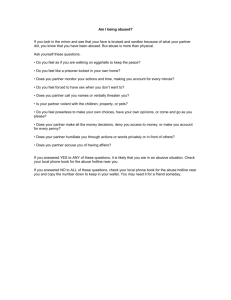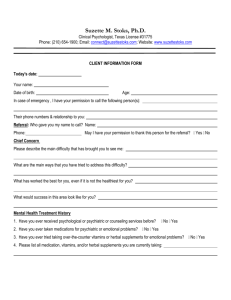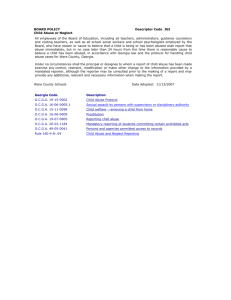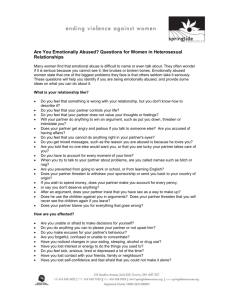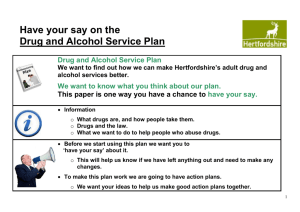Chapter 12 Notes
advertisement
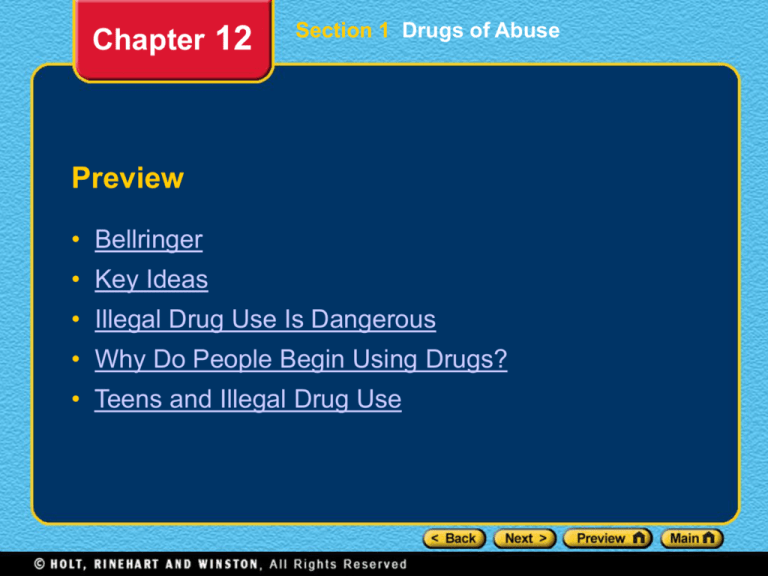
Chapter 12 Section 1 Drugs of Abuse Preview • Bellringer • Key Ideas • Illegal Drug Use Is Dangerous • Why Do People Begin Using Drugs? • Teens and Illegal Drug Use Chapter 12 Section 1 Drugs of Abuse Bellringer • List several drugs that you think are commonly abused. Why do you think people try illegal drugs? Chapter 12 Section 1 Drugs of Abuse Key Ideas • List six ways illegal drug use can be dangerous. • State five reasons a person might try illegal drugs. • Identify the reason drug abuse is especially dangerous to teens. • Describe two ways illegal drug use conflicts with your values and goals. Chapter 12 Section 1 Drugs of Abuse Illegal Drug Use Is Dangerous • Drug abuse is the intentional improper or unsafe use of a drug. • Drugs used for recreational purposes are called drugs of abuse. • Many drugs of abuse are illegal drugs. Possessing, using, buying, or selling these drugs is illegal for people of any age. Chapter 12 Section 1 Drugs of Abuse Illegal Drug Use Is Dangerous • Using illegal drugs is not only against the law, it is also dangerous. Here are some of the reasons: • Illegal drugs can have permanent effects on the brain and the body. • You can become addicted. • You can catch infectious diseases from needles. • You can overdose. • You can lose the ability to make responsible decisions about other risky behavior. Chapter 12 Section 1 Drugs of Abuse Why Do People Begin Using Drugs? • Some of the reasons people try illegal drugs include: • • • • a desire to experiment a desire to escape boredom or depression enjoyment of risk-taking behavior a belief that drugs solve personal, social, or medical problems • peer pressure • glamorization of drugs by the media Chapter 12 Section 1 Drugs of Abuse Teens and Illegal Drug Use • Teens have a higher risk of addiction to drugs than adults do because teens’ brains are still developing. • Drug use or abuse can change the function of the brain. • Altering brain development with drug use can lead to a life-long struggle to overcome addiction. Chapter 12 Section 2 Commonly Abused Drugs Preview • • • • • • • • Bellringer Key Ideas Types of Illegal Drugs Beliefs Vs. Reality Marijuana Inhalants Club (Designer) Drugs Anabolic Steroids Chapter 12 Section 2 Commonly Abused Drugs Bellringer • List some other common names for marijuana, ecstasy, and steroids. Chapter 12 Section 2 Commonly Abused Drugs Key Ideas • List three things all types of illegal drugs have in common. • Summarize the effects of four commonly abused illegal drugs on the body. • Describe the effects of marijuana on a person’s behavior. Continued on next slide Chapter 12 Section 2 Commonly Abused Drugs Key Ideas, continued • Identify the reason abusing inhalants can be deadly after only one use. • Compare the dangerous effects of five types of club drugs. • Summarize the dangerous effects of anabolic steroids. Chapter 12 Section 2 Commonly Abused Drugs Types of Illegal Drugs • There are many types of illegal drugs, but they all have three things in common. 1. They affect the function of the brain. 2. They are dangerous to your health. 3. They can result in drug dependence and addiction. • The following slide gives some information about several common illegal drugs and their effects. Chapter 12 Section 2 Commonly Abused Drugs Beliefs Vs. Reality • You or the people around you may have some misconceptions about the dangers of illegal drugs. • The next slide presents some common beliefs and the facts. Chapter 12 Section 2 Commonly Abused Drugs Chapter 12 Section 2 Commonly Abused Drugs Chapter 12 Section 2 Commonly Abused Drugs Marijuana • Marijuana is the dried flowers and leaves from the plant Cannabis sativa. • The active chemical in marijuana is tetrahydrocannabinol (THC). • People who use marijuana build up a tolerance, so they need more and more to get high. This can lead to physical dependence. Chapter 12 Section 2 Commonly Abused Drugs Marijuana • Common short-term effects of marijuana include: • • • • Slowed thinking ability Difficulty paying attention Distorted sense of time and distance Giddiness Continued on next slide Chapter 12 Section 2 Commonly Abused Drugs Marijuana • Common short-term effects of marijuana include: • • • • • Loss of short-term memory Loss of balance and coordination Increased appetite Anxiety Panic attacks Chapter 12 Section 2 Commonly Abused Drugs Marijuana • Smoking marijuana over a long period has many of the same negative health effects as smoking tobacco. • Marijuana use is also dangerous when driving. The loss of attention and coordination can make driving high as dangerous as driving drunk. • Hashish has the same effects as marijuana, but stronger. Chapter 12 Section 2 Commonly Abused Drugs Chapter 12 Section 2 Commonly Abused Drugs Inhalants • Inhalants are drugs that are inhaled as vapors. • Commonly abused inhalants include paint thinner, glue, gasoline, marker fluid, propane, butane, and nitrous oxide. • Because inhalants are often common products, they can be easy to get and inexpensive. • Inhalants are a common gateway drug for teens. Chapter 12 Section 2 Commonly Abused Drugs Inhalants Inhalants can be extremely dangerous. • Inhalants damage many organs. • Inhalants kill brain cells. • Inhalants can cause sudden death. Chapter 12 Section 2 Commonly Abused Drugs Inhalants Click below to watch the Visual Concept. Visual Concept Chapter 12 Section 2 Commonly Abused Drugs Chapter 12 Section 2 Commonly Abused Drugs Club (Designer) Drugs • Club drugs, also called designer drugs, are drugs designed to resemble other illegal drugs in chemical structure and effect. • Some common club drugs are Ecstasy, GHB, Ketamine, and PCP. Chapter 12 Section 2 Commonly Abused Drugs Chapter 12 Section 2 Commonly Abused Drugs Anabolic Steroids • Anabolic steroids are synthetic versions of the male hormone testosterone that are used to promote muscle development. • Anabolic steroids have a few legitimate medical uses. • Most people take anabolic steroids illegally and without guidance from a doctor. • Unlike most drugs of abuse, steroids have no immediate psychoactive effect. Their primary effects are on the body. Chapter 12 Section 2 Commonly Abused Drugs Anabolic Steroids • The table at right shows some of the side effects of anabolic steroids. • Abusing anabolic steroids can lead to serious health problems. Chapter 12 Section 3 Other Drugs of Abuse Preview • Bellringer • Key Ideas • Other Types of Abused Drugs • Stimulants • Depressants • Opiates • Hallucinogens Chapter 12 Section 3 Other Drugs of Abuse Bellringer • Describe the difference between a stimulant and a depressant. Chapter 12 Section 3 Other Drugs of Abuse Key Ideas • Describe the dangerous risks of using stimulants, depressants, opiates, and hallucinogens for nonmedical uses. • Compare the dangers of two different types of stimulants. • Summarize the dangerous effects of the depressants Rohypnol and dextromethorphan (DXM). Continued on next slide Chapter 12 Section 3 Other Drugs of Abuse Key Ideas, continued • Describe the dangerous physical and social effects of addiction to opiates such as heroin. • Summarize the dangerous emotional effects that can result from hallucinogen abuse. Chapter 12 Section 3 Other Drugs of Abuse Other Types of Abused Drugs • Stimulants are drugs that temporarily increase a person’s energy and alertness. • Depressants are drugs that cause relaxation and sleepiness. • Opiates are a group of highly addictive drugs derived from the poppy plant that are used as pain relievers, anesthetics, and sedatives. • Hallucinogens are drugs that distort perceptions and cause a person to see or hear things that are not real. Chapter 12 Section 3 Other Drugs of Abuse Chapter 12 Section 3 Other Drugs of Abuse Stimulants • Caffeine and nicotine are mild, legal stimulants, although they are addictive. • Amphetamines are a group of stimulants produced in laboratories. They are highly addictive. Repeated use can cause severe damage to the body and brain. Chapter 12 Section 3 Other Drugs of Abuse Stimulants • Cocaine and crack cocaine are stimulants derived from the coca plant. They are also highly addictive. Overdose of these drugs can be very dangerous. Chapter 12 Section 3 Other Drugs of Abuse Stimulants Click below to watch the Visual Concept. Visual Concept Chapter 12 Section 3 Other Drugs of Abuse Chapter 12 Section 3 Other Drugs of Abuse Depressants • Depressants have effects similar to the effects of alcohol. They are highly addictive when abused. • Using depressants in combination with alcohol increases the effects. • Overdose may cause brain damage, coma, or death. Chapter 12 Section 3 Other Drugs of Abuse Depressants • Rohypnol is a hypnotic widely used as a date-rape drug. • Dextromethorphan (DXM) is an ingredient in cough syrups. In high doses its effects are similar to the effects of PCP. Chapter 12 Section 3 Other Drugs of Abuse Depressant Click below to watch the Visual Concept. Visual Concept Chapter 12 Section 3 Other Drugs of Abuse Chapter 12 Section 3 Other Drugs of Abuse Opiates • Opiates, such as morphine and codeine, can be very effective medicines when used properly in limited amounts. • Opiates reduce pain, relieve diarrhea, suppress coughing, and induce relaxation. • When abused, opiates result in addiction very quickly. Withdrawal symptoms are severe. Chapter 12 Section 3 Other Drugs of Abuse Opiates • Heroin is a chemically altered form of morphine. • Heroin is highly addictive. This addiction is debilitating and often ruins people’s lives. Chapter 12 Section 3 Other Drugs of Abuse Opiates • Heroin addicts frequently: • • • • • • lose their jobs have poor living conditions suffer many health problems choke on their own vomit when passed out catch diseases from needles engage in crime to support their addiction Chapter 12 Section 3 Other Drugs of Abuse Chapter 12 Section 3 Other Drugs of Abuse Hallucinogens • LSD is usually taken as tablets or absorbed through the tongue on small paper squares. • LSD can increase energy, alter mood, and produce strange sensations or hallucinations. The effects of LSD can also be frightening. Chapter 12 Section 3 Other Drugs of Abuse Hallucinogens • Mushrooms are a naturally poisonous species of mushroom that produce effects similar to LSD. • LSD and mushroom users can experience flashbacks long after they have taken the drugs. Chapter 12 Section 4 A Drug-Free Life Preview • • • • • • • • • Bellringer Key Ideas Drug abuse Affects the Individual Drug Abuse Affects the Family Drug Abuse Affects Society Treatment for Drug Addiction Principles for Effective Drug Treatment Saying No to Drugs What to Say Chapter 12 Section 4 A Drug-Free Life Bellringer • List as many risks of drug abuse as you can think of. Chapter 12 Section 4 A Drug-Free Life Key Ideas • Summarize how drug abuse can negatively affect a person’s life. • Identify the ways that drug abuse can affect a family. • List four ways that drug abuse impacts society. • Describe the principles that describe effective drug abuse treatment. • List five ways that you could refuse illegal drugs. Chapter 12 Section 4 A Drug-Free Life Drug abuse Affects the Individual • The dangers of intoxication, side effects, and addiction are not the only risks of drug abuse. • Other risks include: • car accidents • accidental injury or death • violence and other criminal activity • unplanned pregnancy • sexually transmitted diseases Chapter 12 Section 4 A Drug-Free Life Drug Abuse Affects the Family • When a teen or other family member is using drugs, it destroys trust within the family. • Drug abuse often leads to family violence. • Drug use can be dangerous to pregnant women and to the fetus. • Neonatal abstinence syndrome is withdrawal that occurs in newborn infants whose mothers were frequent drug users during pregnancy. Chapter 12 Section 4 A Drug-Free Life Drug Abuse Affects Society • Like the use of tobacco and alcohol, drug use imposes economic costs on society. • Billions of dollars are spent in the U.S. each year on health care resulting from drug abuse. • There are also costs from lost productivity at work, accidents, suicide, and other drug-related problems. • Drug abuse and addiction also increase crime. • 1 out of every 4 prisoners is in jail for a drug-related crime. Chapter 12 Section 4 A Drug-Free Life Treatment for Drug Addiction • Recovering is the process of learning to live without drugs. • Because drugs affect the brain, recovering from addiction is very difficult and usually requires treatment and extensive support. • Drug treatment approaches include 12-step programs, outpatient counseling, and residential communities. Chapter 12 Section 4 A Drug-Free Life Principles for Effective Drug Treatment 1. No single treatment works for everyone. 2. Treatment should be available and easy to access. 3. The best treatment also addresses problems other than addiction. 4. Treatment should offer multiple services. 5. The longer an abuser stays in treatment, the more effective it is. 6. Group therapy builds skills for resisting drugs and developing relationships without drugs. Chapter 12 Section 4 A Drug-Free Life Principles for Effective Drug Treatment 7. Medications can be an important part of treatment. 8. Mental illness should be treated along with addiction. 9. Treatment does not need to be voluntary. 10. Patients should be monitored. 11. Programs should test for HIV/AIDS, hepatitis, and other diseases. 12. Recovery may require several periods of treatment to combat relapse. Chapter 12 Section 4 A Drug-Free Life Saying No to Drugs • As with alcohol, tobacco, and other pressures, you should practice and be ready to say “No” to drugs. • • • • • • Say no firmly. Buy yourself time. Give good reasons. State the consequences. Say no again and include an alternate activity. Walk away. Chapter 12 Section 4 A Drug-Free Life What to Say • People who use drugs often use similar “lines” when pressuring other people to join them. The following slide will give you some ideas of how you can respond. Chapter 12 Section 4 A Drug-Free Life Chapter 12 Brain Food Video Quiz Click below to watch the Brain Food Video Quiz that accompanies this chapter. Brain Food Video Quiz
